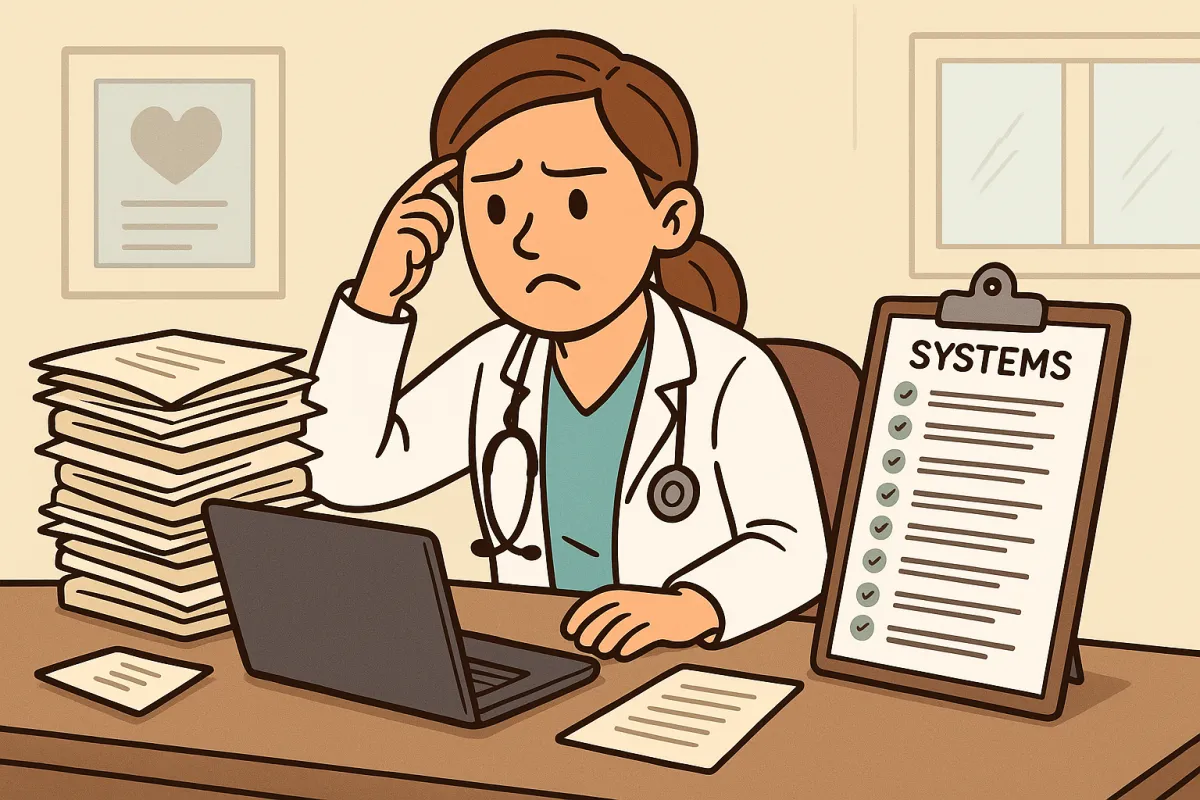Blogs

🧠 Why Systems Are the Secret to a Stress-Free Medical Practice
Your staff don’t need more reminders. They need systems.
Running a specialist medical practice in Australia isn’t just about treating patients—it’s about managing a steady stream of admin tasks, paperwork, people, and problems.For many practices, the pressure is unrelenting.
Here’s what I hear again and again from the doctors we work with:
“Only one person knows how to do that task.”
“When my secretary’s away, nothing gets done right.”
“It takes months for new staff to get up to speed.”
“Constant staff turn over is killing me”
Sound familiar?
The Problem Isn’t Your People—It’s your Lack of Systems
Many practices try to solve this by training harder, hiring better, or leaving sticky notes. But these fixes don’t last.
What makes the difference isn’t reminders—it’s systems.
Systems or as sometimes called Standard Operating Procedures (SOPs) aren’t corporate fluff. They’re the operating manual for a thriving, stress-free, and scalable practice.
What Systems Look Like in a Real Practice
A business system is how you do something in your business—from start to finish—in a documented, repeatable way.
✅ Checklists for repetitive tasks: How to check referrals, send recalls, book follow-up appointments
🎥 Screen recordings that show step-by-step how to do something—whether it’s using Gentu, Xestro or uploading letters and sending them to referring doctors
📄 Templates and scripts for answering patient calls or writing medical certificates
At AIR SECRETARY, our staff are trained to create and follow systems for all tasks. The result? Our secretaries hit the ground running. Our clients experience fewer delays, faster onboarding, and most importantly—less stress.
🛠️ How to Start Building SOPs in Your Own Practice
You don’t need a management consultant. You don’t need to block out a week.
You just need to start. Here’s how:
1. Document as You Go
Start with the tasks you do every day. Next time you’re doing one:
Record your screen (use Loom, Zoom, or built-in screen recorders)
Narrate as you do it: “Now I check for unfiled letters. Next, I go to X. I click Y…”
Save the video and upload it to the system
Turn it into a written checklist, flowchart later or summary of the steps. Once you create the system, your secretary can write the summary of the steps after watching the video so they learn the system.
2. Save It Somewhere Everyone Can Access
Most medical practices store their Systems in someone’s email inbox or in a desktop folder full of Word documents but this defeats the purpose. They should live in a central, always-accessible location. Some reliable options:
Google Sites – Create an internal website with linked systems, checklists, and video walkthroughs
SharePoint – For Microsoft users, this is a secure, structured way to host your practice’s “instruction manual”
Make sure the entire team knows how to access it—and make it part of onboarding for every new hire.
3. Systemise the Right Things First
Start with high-frequency, low-risk tasks:
Checking and sending out patient letters
Issuing medical certificates
Billing for hospital inpatients
Sorting new referrals and booking patient appointments
Handling incoming faxes and emails
Booking procedures or sleep studies
Set a realistic goal: Create 3 to 4 new Systems every day. It adds up quickly.
4. Empower Staff to Build Systems Too
Your team should be trained to:
“If I’ve done this task more than once, it is time to make a system for it”
Encourage every team member—especially admin staff—to create Systems for new or recurring tasks. Make it standard practice.
🧳 Free Yourself: What Can Be Outsourced?
If there’s a task you do regularly that someone else could do with the right instruction—systemise it and delegate it.
Examples from our clients:
✅ Reviewing and uploading dictated letters
✅ Checking patient appointments to ensure all investigations are present in the file
✅ Billing hospital inpatients
✅ Following up patients who need review appointments made
✅ Filling in PBS application forms
With a clear System, these tasks can be delegated to your Air Secretary or in-house staff—freeing you up to focus on clinical work and big-picture decisions.
🧭 A Practice That Runs Itself? It’s Not a Fantasy.
With Systems in place, your practice becomes less reliant on individuals—and more reliant on systems. Staff turnover doesn’t bring chaos. Sick leave doesn’t stall the week. Everyone knows what to do, how to do it, and where to find help.
That’s how we run things at AIR SECRETARY — and that’s how we help our clients do the same.
📩 Want help building Systems or outsourcing admin?
Visitairsecretary.com to contact our team.



